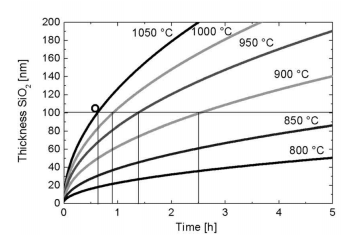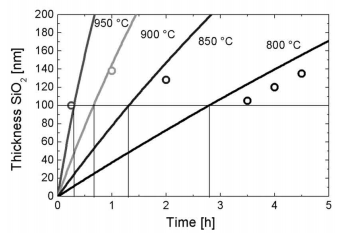ABSTRACT: For solar cells with highest efficiencies, thermally grown oxides are used for surface passivation. In this paper we compare wet oxidation in pyrogenic steam ambience at temperatures in the range from 800 °C to 900 °C with dry oxidation at 1050 °C. The wet oxidation process is suitable for mono- and multicrystalline silicon and does not degrade minority carrier lifetime. At the same time it maintains the high quality of surface passivation. The application of the wet oxide in a simplified process scheme with laser-fired rear contacts leads to conversion efficiencies under standard testing conditions of 20.3 % for multicrystalline and 21.2 % for monocrystalline silicon solar cells on small device areas (1 cm2 ).
Keywords: High-Efficiency, Multi-Crystalline, SiO2
1 INTRODUCTION The electronic quality of multicrystalline silicon (mcSi) has improved significantly in recent years due to a substantial reduction of impurity contamination and advanced gettering and bulk passivation techniques. As a consequence, the minority carrier diffusion length easily exceeds wafer thickness, a fact which is amplified by the general move to thinner substrates. This creates the need for a solar cell design with high-quality surface passivation. With phosphorus diffused emitters with a sheet resistance of around 100 Ω/sq contributing only little to recombination, the emitter can be described as a minor loss mechanism whereas rear surface passivation becomes increasingly important. Efficiencies of mc-Si solar cells exceeding 18 % with aluminium back surface field [1] and silicon nitride [2] have been reported, but the best results so far have been achieved by oxide passivated rear surfaces with locally defined contacts [3]. This superior performance of oxides together with additional restrictions arising from the above mentioned other techniques (i.e. limited passivation quality of aluminium back surface field or wafer bending), as well as shunting of the field effect for silicon nitride [4], make thermal oxidation a promising technology for the production of high-efficiency mc-Si solar cells. High-temperature thermal oxidations at more than 1000 °C are commonly used for the production of highefficiency silicon solar cells from high-quality monocrystalline silicon. The application of processes with such high temperatures to solar grade multicrystalline silicon usually leads to a drastic degradation of minority carrier lifetime [5,6]. In this paper we present wet oxidation in a pyrogenic steam ambience at temperatures between 800 °C and 900 °C as an alternative to dry oxidation at 1050 °C. This process is well suited for both mono- and multicrystalline silicon, and does not lead to a significant degradation in minority carrier lifetime whereas showing excellent electrical and optical properties as well as full compatibility with the LFC [7] cell structure. The material we used was multicrystalline silicon produced by ScanWafer, Kawasaki Steel and monocrystalline FZ silicon manufactured by Siltronic.
2 PHYSICAL PROPERTIES OF WET OXIDES In this section we analyse the growth kinetics and the passivation properties of the oxides grown under dry and wet conditions at different temperatures. 2.1 Growth dynamics of wet oxidation According to the model of Deal & Grove [8], the oxidising species has to diffuse through the already existing SiO2 layer since the oxidation takes place at the Si-SiO2 interface. The growth of the oxide layer is well described by a linear-parabolic function of time (see Fig. 1). At 1050 °C it takes about 40 minutes to reach an oxide thickness in the order of 100 nm.

Figure 1: Calculated oxide thickness under dry oxidation conditions for <100> oriented silicon as a function of time. The hollow symbol shows an experimental data point.
According to the calculation, a reduction of processing temperature to 800 °C would prolong the processing time to about 20 hours. This is far too long for any practical process and probably harmful to multicrystalline silicon. In addition to smaller changes in the parameters (increasing gas pressure, addition of DCE etc.), a major step towards a decreased oxidation temperature can be achieved by additional water steam during oxidation. Fig. 2 shows the calculation and experimental data with adjusted parameters for wet ambience. The oxide growth is enhanced and it is possible to choose a parameter set of time andtemperature with greatly reduced thermal budget to achieve an oxide thickness of about 100 nm. Considering the application on mc-Si, it has to be noted that the oxide growth is heavily dependent on crystal orientation with other orientations than <100> showing increased growth rates

Figure 2: Calculated oxide thickness under wet oxidation conditions for <100> oriented silicon as a function of time. The hollow symbols show our experimental data.
上一篇: 交叉污染对CMP后清洗过程的影响
下一篇: 光刻微光学工艺